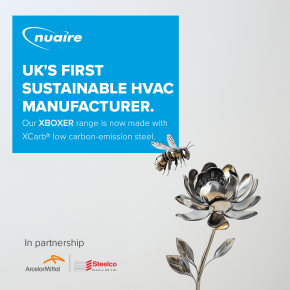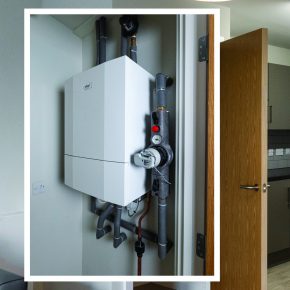
GUEST ARTICLE: Shining a light on the sheds
This guest article sees Simon Cox, head of sustainability at Prologis in the UK, take an in-depth look at modern warehouses, including how can be utilised and what the future holds for them.
What does the modern warehouse or distribution centre look like?
“Today, modern warehouses are key to ensuring the success of their occupiers: helping businesses reduce operational costs, demonstrate a commitment to sustainability and attract and retain employees.
To help occupiers achieve these things, the modern warehouse needs three key components.
Firstly, the building needs to be energy efficient. Lighting, for example, accounts for 90 percent of energy use in a logistics building and, with many occupiers operating 24 hours a day, LED lighting and remote energy monitoring systems can help to reduce costs and provide occupiers with valuable data about where energy is being used.
Solar panels linked to battery storage units can also offset high energy costs during peak charging periods.
The second thing a building needs to provide is the flexibility to accommodate changing occupier needs. With the rise in automation and the use of electric vehicles, for example, today’s buildings must be designed with future needs in mind.
Lastly (and perhaps most importantly, given a global shortage of labour), logistics buildings need to help occupiers attract and retain staff. Today, logistics companies are competing with other sectors such as retail and office for a diminishing pool of labour.
Therefore, attracting and retaining employees is at the top of everyone’s agenda and the warehouse has an important role to play. Green spaces, an employee gym and on-site café are just some examples of features you might find in and around the modern warehouse.”
Have you noticed any trends influencing demand for warehouse space?
“Thanks to the continued rise of online retail and the consolidation of supply chains, the role of the warehouse has moved from ancillary function to a core and central part of the business operation; it should be equally as good as a company’s flagship store in terms of build quality, efficiency and employee welfare.
End-user and customer demand for a sustainability at all points of the supply chain means the sustainability credentials of the warehouse, in which goods are stored and packed are also increasing in importance.
As well as certificates of environmental performance, occupiers expect their property partner to be able to provide them with robust metrics to evidence that the building is low-carbon, both operationally and in terms of its structure and fabric.”
What about cost – how significant is that when choosing a warehouse facility?
“It’s important to remember that the cost of the renting and servicing the building is only a small part of an occupier’s operational costs (around 5 percent); however, it’s an area where cost reductions are welcomed and where the design and construction of the building can deliver real benefits.
Sustainable buildings, for example, are efficient by their very nature and the use of clever design and equipment (such as remote energy monitoring systems) can also help further reduce costs for the occupier.”
How important is natural light in modern warehouse design?
“Warehouses in the UK are typically ambient spaces without heating or cooling systems and natural light has an important role to play in creating a pleasant working environment for employees and reducing energy costs.
When you consider that natural light can reduce overall energy consumption by 70-80 percent and increase employee wellbeing, it’s clear that this is a critical element of the modern warehouse.
Research directly links increased employee wellbeing with access to natural light. Therefore, the provision of 15 percent rooflights and green outdoor spaces where employees can spend their break periods are key to creating a building which benefits employee welfare.”
What does the future hold for modern warehouse design?
“As more and more people purchase goods online, warehouses will need to adapt to an increased need for automated processes, energy efficiency and a requirement to build facilities closer to where people live and work.
Multi-level buildings, increased facilities for electric vehicles and a greater requirement for energy to power automated systems will all influence future building design, and warehouse systems will need to grow and adapt to accommodate future uses.”
Latest news

28th April 2025
Nuaire first UK ventilation manufacturer to use low carbon-emissions recycled & renewably produced steel
Nuaire has announced that its Magnelis® steel based ventilations systems are now being made from XCarb® recycled and renewably produced steel.
Posted in Air Conditioning, Articles, Building Industry News, Building Products & Structures, Building Services, Building Systems, Heating, Ventilation and Air Conditioning - HVAC, Restoration & Refurbishment, Retrofit & Renovation, Steel and Structural Frames, Sustainability & Energy Efficiency, Waste Management & Recycling
28th April 2025
Renderplas: Builders avoid costly remedial work with PVCu render beads
A pioneer of PVCu render beads, Renderplas is helping the construction industry avoid the costly remedial work associated with rusting steel designs…
Posted in Articles, Building Industry News, Building Products & Structures, Building Services, Building Systems, Facades, Posts, Render, Restoration & Refurbishment, Retrofit & Renovation, Sustainability & Energy Efficiency, Walls
28th April 2025
How Celotex’s Technical Team adds value through expert insulation support
From U-value calculations to real-world installation support, Celotex’s technical team helps construction professionals specify and install insulation with confidence…
Posted in Articles, Building Industry News, Building Products & Structures, Building Services, Insulation, Research & Materials Testing, Restoration & Refurbishment, Retrofit & Renovation, Sustainability & Energy Efficiency, Walls
28th April 2025
Ideal Heating Commercial takes extra care with the heat network at Huddersfield specialist housing development
Ideal Heating Commercial POD Heat Interface Units (HIUs) and Evomax 2 condensing boilers have been installed into Ash View Extra Care in Huddersfield.
Posted in Articles, Building Industry News, Building Products & Structures, Building Services, Case Studies, Facility Management & Building Services, Heating Systems, Controls and Management, Heating, Ventilation and Air Conditioning - HVAC, Pipes & Fittings, Plumbing, Restoration & Refurbishment, Retrofit & Renovation
 Sign up:
Sign up: